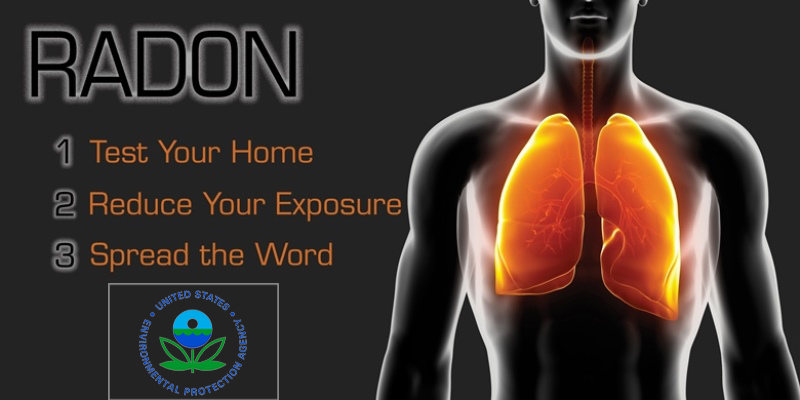
What is Radon?
Radon is a cancer causing, radioactive gas. You cannot see it, smell it or taste it. Radon is produced by the natural breakdown of uranium in soil, rock and water. High levels of radon have been found in every state in the US. One in fifteen homes in the US have radon levels above 4 picocuries per liter (4pCi/L), the EPA action level.
Health Effects of Radon
Radon is the second leading cause of lung cancer in the United States. Of the 160,000 lung cancer deaths annually in the United States, about 12% are due to radon exposure. The remainder is due to smoking. According to the National Academy of Sciences, radon is estimated to cause about 21,000 deaths per year.
Sources of Radon
Radon gas can enter a home from the soil under the house by process of diffusion through concrete floors and walls, and through cracks in the concrete slab, floors, or walls and through floor drains, sump pumps, construction joints and cracks or pores in hollow-block walls. Normal pressure differences between the house and the soil can create a slight vacuum in the basement, which can draw radon from the soil into the building. The design, construction and ventilation of the home can affect the radon levels of the home.
Where to test
The EPA recommends that all residences below the third floor level be tested for radon. In addition, the EPA also recommends testing all rooms in contact with the ground or over crawlspaces in schools. If you have tested your home, you should retest every two years since radon levels can change with structural changes in the home. If you decide to use a lower floor of your home, such as a basement, you should test this level before occupancy. In addition, you should always test prior to the purchase of a home.
Radon in Real Estate Transactions
If you are thinking of buying a home, you should have a radon test done before purchase. You may want to consider including provisions in the real estate contract specifying details about the radon test. Make sure the test is done in the lowest level of the home suitable for occupancy. In addition, we recommend using a Professional Tester to conduct the radon test, according to EPA or your state’s protocols.
Two Types of Tests
Short Term Tests and Long Term Tests.
Short term tests measure radon levels for exposure periods of 2 days to 90 days, depending on the device. Short term testing is extremely useful when you need results quickly such as during a real estate transaction. Most common tests for radon last 2-7 days.
RTCA® offers the following short-term tests:
- Charcoal canister single pack
- Charcoal canister double pack
- Liquid scintillation vials (Government programs only)
- Continuous radon monitors
Long term tests measure radon levels for 90 days to one year. These tests give results which are more likely to reflect the seasonal or year round average radon level of the home.
RTCA® offers the following long-term tests:
- Long-term electrets
How to Test
Using a test kit that meets the EPA requirements, place the test kit in the lowest level of the home suitable for occupancy, at least 20 inches above the floor. The test kit should not be placed in the bathroom or kitchen, where the humidity and use of fans could effect the test results. If a short term test lasting less than 4 days is conducted, doors and windows should be closed 12 hours prior to and throughout the testing period. If the test lasts up to 7 days closed house conditions are recommended. Short term testing should not be done during severe storms or periods of unusually high winds. Place the test kit in an area that will not be disturbed and away from drafts, high heat, high humidity and exterior walls that may have windows or doors. Carefully follow the directions in the test kit and leave it in place for the time period noted in the instructions.
How to Interpret Test Results
Radon is measured in picocuries per liter [pCi/L]. Levels at or above 4 pCi/L should be reduced through mitigation. For more information on reducing levels of radon in your home, request a copy of the EPA Consumers Guide To Radon Reduction, “How to Reduce Radon Levels in your Home” or contact Brian Wert for guidance.
If Radon Levels Are High
You have tested your home for radon and confirmed that you have elevated radon levels — 4 picocuries per liter (pCi/L) or higher. The EPA recommends that you take action to reduce your home’s radon levels if your radon test result is 4 pCi/L or higher. High radon levels can be reduced through mitigation.
The EPA, Surgeon General & National Cancer Institute, among others, recommend that all home buyers test for radon. If high levels of radon are present mitigation is possible. Click below for more information.
Click here for more information on the Environmental Protection Agency (https://www.epa.gov)

